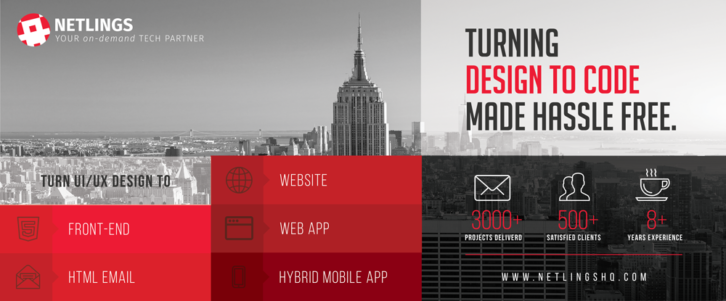The Best Design to Code Services for You in 2017
Given a choice, web designers prefer to focus on the aesthetics of web design. What they produce doesn’t always have to look all that gorgeous however. What’s more important is that it’s user-friendly, cross-browser compatible, fast loading, and semantic.
Incorporating these nuts-and-bolts features into a website can be tedious, and not always a lot of fun when creative design is your thing. Having a Photoshop mockup that you can hand over to a developer can be a big help. The developer can then convert your design to HTML/CSS.
If you would rather not take time to code your designs, or you don’t possess the skills to do so, it’s best to get some expert help to get the job done. While there’s no shortage of coding services, you want to choose one that will be do your design justice. And, also, give you a product that will faithfully carry out its intended purpose.
PSD to Manythings is a team of richly-talented, highly-experienced professionals that provide reasonably priced frontend solutions. Serving agencies, design studios, and freelancers, this service will treat your designs with care, and deliver groundbreaking responsive HTML5/CSS3 websites to your doorstep.
The PSD to Manythings team will code up your website to perform on devices ranging from Android phones to 27-inch iMacs. The markup code delivered is W3C validated, and SEO friendly.
Besides PSD to HTML5 and PSD to Responsive HTML5, their services include PSD to Twitter Bootstrap, PSD to WordPress, PSD to WooCommerce, PSD to E-mail Newsletter. They also convert Sketch to HTML, and PSD to SquareSpace.
You won’t be subjected to a sales pitch to purchase something you don’t need, and the team prides itself on on-time deliveries. Deadlines quoted take into account QA, testing, and development. Their pricing is competitive, and they have a no-questions-asked, money back guarantee. Customer support is always available through live chat, over the phone, or by e-mail.
Direct Basing provides development solutions that can help you speed up your workflow. Companies and agencies will save money by handing designs over to Direct Basing rather than pay costly salaries to full-time developers. Freelancers can make more money by being able to take on additional design work instead of spending their time slicing and coding.
Services include PSD to HTML5, WordPress, Email and Joomla.
Request a free price indication, upload your project (Dropbox or WeTransfer), receive their no-obligation offer, and one of more of their 40 skilled developers, located in several time zones, will get started. Your project will be delivered on time, but only after it has undergone a rigorous check for errors.
The source code is well structured, so any customer having programming knowledge can easily adjust it when needed.Â
Xfive is a web development agency that brings over 10 years of experience to the table. Their services include both frontend and backend development, WordPress development, Design (Photoshop, Sketch, AI) to HTML development, and more. If the service you need isn’t listed, you’re still invited to submit your project, and they will let you know what they can do.
Xfive works hard to propose the best technical solutions; or when necessary, adapt to your specific development needs. Their production processes are modern, innovative, and completely transparent.
Where Xfive stands out is their ongoing objective of partnering up with their clients and customers. What this means to you, is close collaboration with you from the time your project is handed over to them until completion, and on into future support. Xfive has main offices in San Francisco, Melbourne, and Krakow, plus a worldwide network of remote developers.
Netlings is another excellent choice. Their preferred MO is to work with you as a partner, or as an extension to your design team. They easily take on large development projects, and they are ready and willing to help you with the small stuff and support issues as well.
Another thing that’s good to know: Netlings once again (2017) has been placed among the top web and mobile developers.
Tips on Preparing Your PSD Files for Conversion
If you want your PSD files converted to HTML quickly and accurately, there are some things you need to attend to first. Try as you might to keep your Photoshop etiquette intact, things can happen that prevent your PSDs from arriving at the developer optimal condition.
Time crunches, the re-emergence of an old work habit, or an ill-timed bout of laziness, can get in the way of preparing your files as they should, and they may not be in the best condition to support a collaborative workflow. Most developers prefer working as partners, but that can be difficult when everything is not organized as it should be.
It’s important to keep the following practices in mind, and especially so when multiple collaborators are involved.
Organize Your PSD
In general, a structured and organized entity will lead to a successful outcome. This holds true as well when organizing PSD files to be delivered for PSD to HTML conversion. When a PSD file is nicely organized, it helps both the coder and the layout designer, and boosts their productivity. For example; every minute that is taken up searching for a graphic layer, text layer, or section, that has been misplaced or misnamed, adds to production time, and to the cost of a project.
Name Everything
If you’ve familiarized with some of the CS6 Photoshop improvements, you’ve no doubt noticed a new Adobe feature that allows you to use search functionality for your layers. With this feature in place, there’s no reason not to name layers in Photoshop.
Establishing simple naming and color conventions for changed states in a PSD makes life easier for everyone.
Be sure to establish an easily understood naming convention for dealing with multiple states in a PSD; one that a new collaborator can quickly acknowledge.
Prepare Rollovers
As you prepare your design, give some thought to the functionality of the links and call to action elements you’re incorporating. Standard practice is to add rollover states to these elements to distinguish among the action states. Some designers tend to put preparing rollovers until later, when they are working with live templates for example. That practice can increase production time.
Do not use Blending Modes
Blend modes may work great in Photoshop, but it’s impossible to recreate them in CSS. While blend modes can shorten image processing time, they produce unintended and undesirable results in website images or HTML/CSS code. Use blend modes for preview purposes if you choose, but not for production work.
Think about Content Flexibility
Some designs fix the amount of text that can be placed over a specific area. While this may work, instances often arise when additional text is needed. Plan ahead.
Fonts, Logos, and Other Assets
When using special fonts in a PSD, it’s always a good idea to make it known to your fellow collaborators and the developers. Make it a point to include them in a special assets folder that accompanies your PSD. The same applies to logos, supporting content, and other project-related assets.








